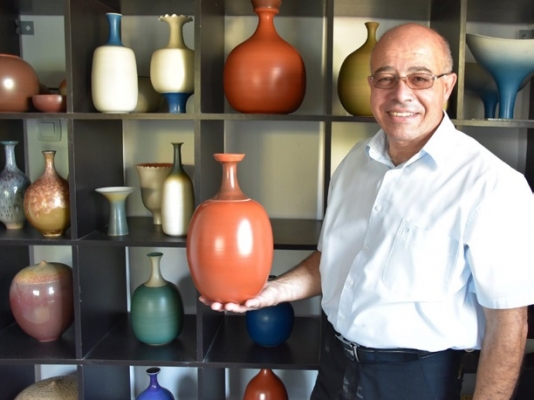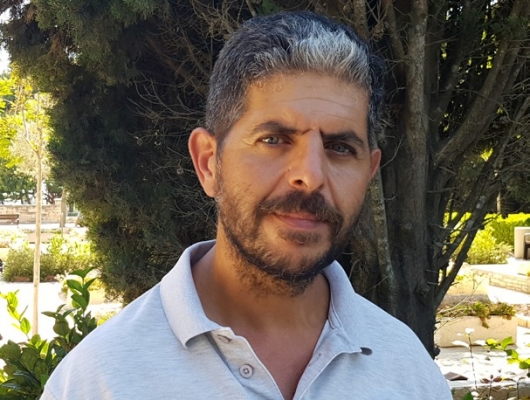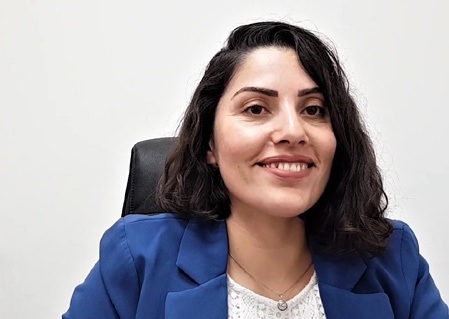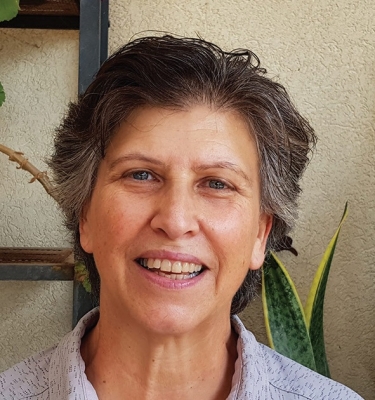The Tapestry of Israel
Photos by Anat Harrel
Most tourists, and even many Israelis, are neither really aware of what a rich mosaic of peoples and communities makes up the kaleidoscope of society that is Israel, nor of how these diverse groups of citizens of Israel self-identify.
The intriguing opportunity of exploring and meeting some of these communities in the Galilee, virtually, in an ongoing series of zoom sessions has been facilitated by ESRA Five Towns together with ESRA Ramat Aviv during the various stages of lockdown experienced in Israel when travel has become a rare commodity.
Expert guide, Anat Harrel, has been delivering informative, live, audio-visual presentations explaining the history and culture of each community and entitled "The Tapestry of Israel". These are interspersed with her own videos which lead and welcome us into the streets - and even the living rooms - of individuals who reveal their stories and thoughts to her.
"Tourists are not aware that 20% of Israel's population are Israeli Arabs and they are always very surprised that this ratio is 50/50 in the Galilee," she explains.
Communities covered so far include the Druze, the Bedouins, the Melkite Christian Arabs, and the Muslim Arabs. Next up on Monday evening, May 31, are the Circassians. It is planned that these talks and virtual tours will come to fruition as actual tours in the near future.
I interviewed Anat to remind me of details about the communities, their members and herself. So, let's dive in for a taste of these fascinating tours.
The Melkite Christian Arab Community
Anat introduces us to the Greek Melkite Catholics who converted to Christianity in Antioch 1,700 years ago and were originally a Greek-speaking community. After the Arab conquest they gradually changed to Arabic in both prayer and speech.
Anat tells me that although they are the largest group of Christian Arabs in Israel, most people have no idea that there are Christian Arabs who pray in Arabic.
Of the half a dozen whom we meet, one of her most interesting subjects is Kamil Sari, an archaeologist who holds the respected position as Director of the Northern Region of the Israel Antiquities Authority covering the Galilee and the Golan Heights. In fact, Anat tells me, the profession attracts a high proportion of Arabs and there is no discrimination.
We get to meet the charismatic Kamil twice including once in his home in the Ein HaYam area of Haifa, near the sea. Thanks to Kamil's protracted lobbying efforts, signs in the area now also bear its Arabic name of Wadi al-Jamal.
We get to hear an extraordinary tale illustrating the history of relations between Jews and Arabs in his neighborhood where there were, and still are according to Anat, "some issues."
Kamil stands in his grandfather's house in the area from which his grandfather and, we are told, 80 % of Haifa's Arabs, fled during the 1948 War of Independence. His and many Christian Arab families moved across Haifa to Wadi Nisnas.
He further elaborates, displaying a wry smile, that when his family came back to their house a Jewish family was living in it and his grandfather resorted to securing a loan to buy it back from them.
Yet, when Jews from Arab lands came to live in the area in the early 1950s and one of the new families could not afford a home his grandfather obtained a loan from the church to give to this Jewish family.
So, we learn that the residents of his neighborhood decided that the past is the past and that they now have to live together. A presence in Kamil's life from whom he loved and learned was the late Jewish ceramicist, Israel Bankir. Bankir rented the basement of the Sari family home as a studio and many of his delightful pots (see picture) are still there. Kamil has undertaken the task of caring for the collection and selling off the pieces.
Even Kamil and his wife were from different denominations, Kamil being Greek Melkite and his wife from a Latin Christian denomination who converted to Greek Melkite. Their first language is Arabic and this is their language of prayer too.
How does this community self-identify? Kamil defines himself as a Melkite Christian Arab "citizen of Israel" rather than simply as an Israeli. This slight nuance is significant and telling. We are told that he is proud of his Palestinian culture.
The Druze
Anat clarifies that the Druze emerged 1,000 years ago as an off-shoot of Ismaili Shi'ite Islam in Egypt under the Fatimid Empire and spread throughout the Levant. Especially after being persecuted as heretics, they fled to the high mountains of the Levant, initially in the areas that came to be Lebanon, then later Syria, and eventually Israel in the 16th and 17th centuries where they settled in the Galilee and Mt. Carmel areas. Their religion is somewhat esoteric and they revere the biblical Jethro.
In this 'tour', which Anat tells me tourists have found fascinating, we meet five Israeli Druze. One is Anat's highly knowledgeable fellow guiding-course student Ehab Zidan, as he wanders his home town of Isfiya, which, together with Daliyat al-Karmel, constitute the two Druze towns on Mt Carmel.
Ehab served in the IDF and was a prison guard before taking the tour guide course as a colleague of Anat. He reveals the main principles of the religion. He emphasizes the community's loyalty, patriotism and commitment to Israel and, as if to underscore this, we are shown the cemetery.
Druze men serve in the IDF and many continue in it as a career along with the police and prison service. As a result, the community suffers a disproportionate number of deaths. Anat reflects to me that they are "caught in the middle" as they speak Arabic but chose the Jewish side in the 1948 War of Independence. Despite being Arabic speakers the Druze identify as Israeli.
The Bedouin
The Bedouin, we learn, are the Muslim Arab descendants of nomadic tribes from Arabia. While those in the Negev continue that lifestyle, other tribes who moved to the fertile Galilee turned to farming.
We get to 'meet' Israel's first Bedouin ambassador, Ismail Khaldi, who shows us his home town of Khawaled.
Ish, as he is known to Facebook friends, is something of an international star with a strong Facebook following. He is an Israeli diplomat who was born the third of eleven children and lived in a Bedouin tent until the age of eight, walking miles to school and tending sheep.
Nevertheless, he served in the IDF and the Israeli police, obtained degrees from Haifa and Tel Aviv universities, and, after several postings abroad, was appointed ambassador to Eitrea last year. He defines himself as an "Arab Bedouin Muslim citizen of Israel." He attributes Bedouin relations with the Jewish community in the Galilee to relationships built with Jewish pioneers in the 1920s. One of his recent projects has been a highly successful public campaign to get a proper road into his home village.
We also 'meet' another trail-blazing member of the community -Israel's first Bedouin woman to be elected to public office. Zainab Abu-Swaid is an elected representative to the council of Kaabiya Zarzir.
The Muslim Arabs
The Muslim Arabs swept throughout the Byzantine Christian controlled Levant and had conquered Jerusalem and the territory covered by modern Israel by 638 CE. Anat explains that many local people converted to Islam, and as Europeans and then Jews came much later in the 19th and 20th centuries, there was again an influx again of more Muslim Arabs from surrounding areas.
We focus on this group last owing to their being the most difficult to portray. Are they Palestinian or Israeli? "They are both," she says -"Muslim and Arab, citizens of Israel with a Palestinian culture."
We meet several Muslim Arabs, and Anat does not shy away from asking: "Who are you? What are you?" For example, there is Ahmad Kanaan, an artist from the lower Galilee village of Tamra, who identifies himsef as a 'citizen of Israel' but believes in the right of return for Arabs and a binational state. Anat tells me: "I don't believe that at all, but we have to accept that there are different ways of being an Israeli."
A sample of the future of Arab women is presented to us in her living room. The charming and highly articulate high school graduate,18-year-old Rima Darawshi lives in Arraba and is preparing for her psychometric exams with a view to studying medicine and becoming a surgeon. Her eloquence is borne out by her having represented Israel in international debating competitions in Thailand and Greece and at Yale University in the USA. We meet her mother too who set an example through education.
Participants are fascinated too by the life of Ibrahim, a young man working as a strategy analyst on this side of the fence facing a hostile Lebanon and Syria.
*ESRA Five Towns together with ESRA Ramat Aviv plan to turn their virtual tours into reality events in the near future as restrictions are lifted. Demand is expected to be high but numbers will be limited – unlike the virtual sessions.
Tour guide Anat Harrel was drawn to live on Kibbutz Hannaton in the lower Galilee when she made aliyah 10 years ago because of the region's "amazing diversity" with a population made up of 50% Jews and 50% Arabs. "We have in the Galilee a shared existence that is unequalled anywhere in the world," she claims, adding, "We all live a pretty good existence, not perfect, but pretty good."
They say that necessity is the mother of invention. Since there have been no tourists in Israel for the past year, Anat explains, "There are now people who can travel to Israel virtually whereas before they could not do anything and they are very happy to have the opportunity to "virtually tour." In May, thanks to her connection with former Kibbutz Hannaton residents Bebe and Laurence Jacobs and his co-chairing of the ESRA Five Towns branch, Anat started providing ESRA virtual tours on Zoom, and has slowly developed a pool of eager Israeli and American virtual tourists and even the residents of old age homes there who could no longer even hope to visit Israel
Whereas other guides show tourists the famous sites, Anat has developed nine virtual tours spotlighting the diversity of the peoples of the Galilee. Other virtual tours by Anat include a presentation of Haifa as a "shared city" and a program with Conservative rabbi, Amy Levin of Kibbutz Hannaton, called "In the Footsteps of the Sanhedrin", featuring the excavations at Usha and tying in textual Mishnaic segments.
A new departure especially aimed at foodies is a cookery show with a chef preparing a gourmet picnic on Mt Gilboa with a Q&A, which also includes a 10-minute tour of Bet Shean.
Anat's particular skill lies in her ability to develop a rapport with her subjects thanks to her obviously genuine interest in them and their stories. Despite being faced with a variety of narratives, she manages to get her subjects to open up because she aims to be non-judgmental and just allow herself to listen to what they have to say, whether or not she agrees with them personally.
Her own background is geographically and culturally diverse and is somewhat of a story in itself. Born in Israel in 1962, her parents took her the following year to Tanzania where her father represented the IDF helping the Tanzanian police build transistor radios. For the next three years she was with them back in Israel in Bat Yam before her parents took her to live in Lima, Peru, for 10 years where she was educated from third grade through to graduation from the American High School.
At the age of 18, she returned to Israel as a lone soldier and completed her army service after which she was offered a place to study archaeology in Israel but decided to return to the U.S. where her parents were now based in Palo Alto, California. She graduated in Physical Education and Middle East Studies from Penn. State University.
Then she "basically got stuck in the US", marrying and producing a daughter. "Life got in the way," she admits. Her Spanish from Peru came in useful as she became a teacher and specialized in bilingual Spanish and English education in Salinas, California, whereas in the San Francisco Bay Area she taught humanities at a Jewish day school.
After divorcing, Anat met her husband on JDate in its first year of operation in 1988 and married her Bostonian husband Yitzhak Santis in 1989. He brought his two daughters to the marriage and they produced another together making a family of four girls.
Anat spent some time in the business world before the couple decided to make aliyah in January 2011, with Anat being technically a returnee. They chose the Masorti Kibbutz Hannaton in the Lower Galilee, 12 km north of Nazareth. Founded in 1983, the kibbutz is situated to the west of the ancient Tel Hannaton.
Their eldest daughter is in Durham, UK, and has a baby whom Anat looks forward to being able to see before too long. Daughter number two is in Holland, number three in Tel Aviv, and her youngest is in the army.
ESRA Five Towns and ESRA Ramat Aviv have produced highly popular Zoom webinars. While Anat's Tapestry of Israel has attracted more than 100 participants, so too has a classical music series with acclaimed lecturer and critic Omer Shomrony. Other sessions have featured the Ethiopians of Israel, personal insights into the lives of the Beatles, the battles of British Israel advocates Mark Lewis and Mandy Blumenthal and a peak into Jewish life in the UAE.












Comments